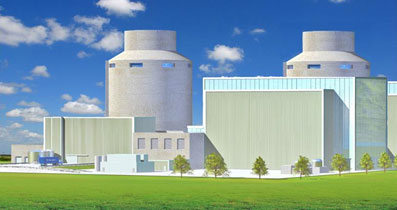AP1000 concerns for NRC
23 May 2011
Westinghouse is working to address AP1000 shield design and peak containment pressure concerns raised by the US Nuclear Regulatory Commission (NRC) in its review of the amended reactor design.
 |
| Westinghouse's AP1000 |
The AP1000 was the first Generation 3+ reactor to receive design certification from the NRC, in 2006. The NRC is currently considering an application to amend the design of the 1100 MWe pressurised water reactor, and earlier this year the regulator approved the issuance of the proposed certification rule while noting the need for "additional calculations" to confirm technical analysis carried out by staff.
Now, the NRC says, those efforts have led to the uncovering of "additional technical issues" which it says Westinghouse must resolve before the regulator can consider finalising its certification of the design. Specifically, questions have been raised about the AP1000's shield building and the peak accident pressures expected within the containment. Westinghouse must "prove to our satisfaction that the company has appropriately and completely documented the adequacy of the design," the NRC says.
In a statement, Westinghouse confirmed it is working to provide the confirmations required by the NRC. None of the issues identified are of safety significance, the company noted, adding that several of them had already been identified by the company itself. "The AP1000 is a safe, robust design and is worthy of receiving design certification," the company said.
Design certification is part of US efforts to streamline the construction of new nuclear power stations. Once a generic reactor design is certified, only site-specific licensing procedures and a combined construction and operating licence (COL) are required for a reactor of that type to be built anywhere in the USA. AP1000s are planned or proposed for various sites in the USA, and the regulator has received COL applications for 14 units to date. Pairs of AP1000s are already under construction at Sanmen and Haiyang in China, and more are planned.
The AP1000 makes extensive use of so-called passive safety features, meaning the plant's cooling system relies on inherent systems based on for example gravity, natural convection, or temperature resistance, rather than active controls or operator intervention in the case of an accident. Earlier this year, the NRC's Advisory Committee on Reactor Safeguards (ACRS) announced they were satisfied that the design would be able to withstand the impact of a large commercial aircraft.
The NRC expects to receive the additional information from Westinghouse in early June, but has not yet determined what impact the delay may have on the schedule for the design amendment and related licence applications.
Researched and written
by World Nuclear News